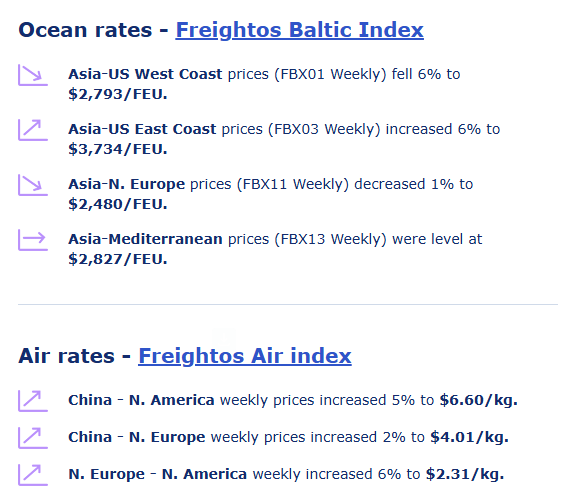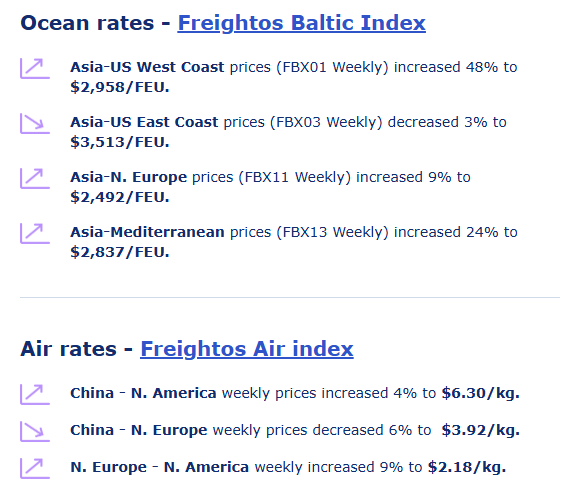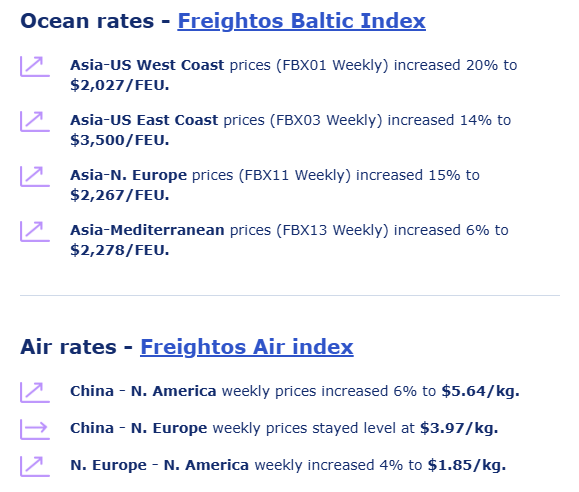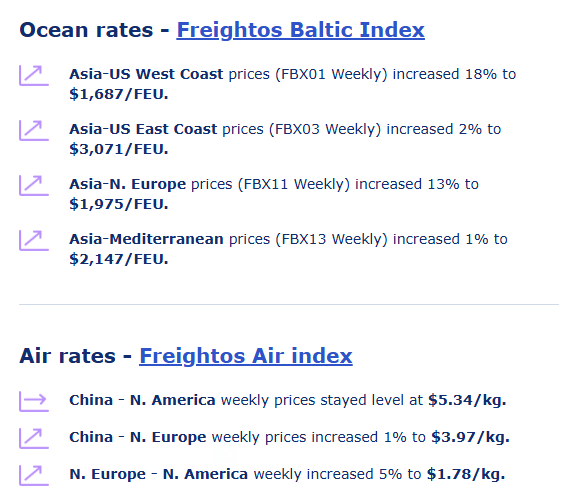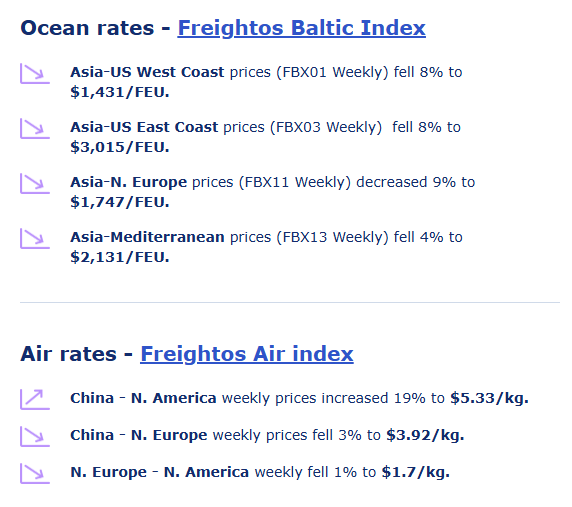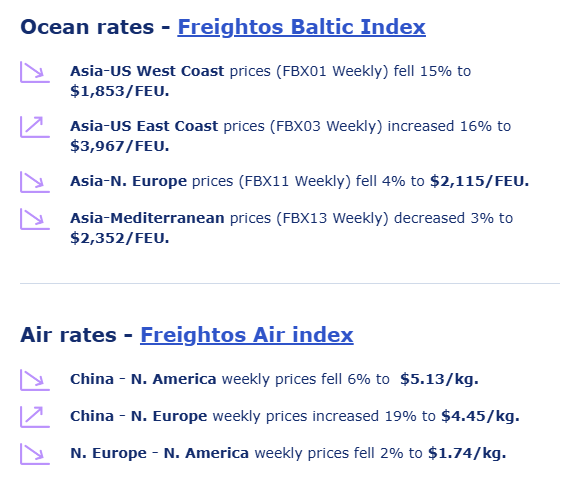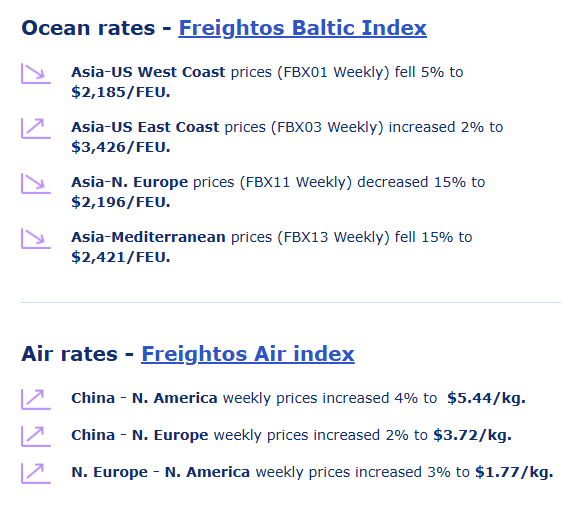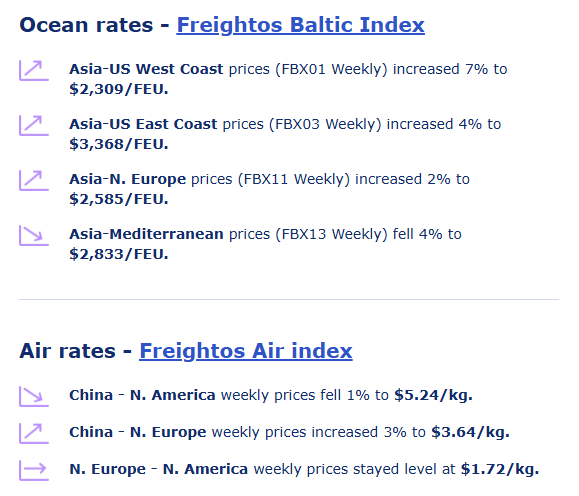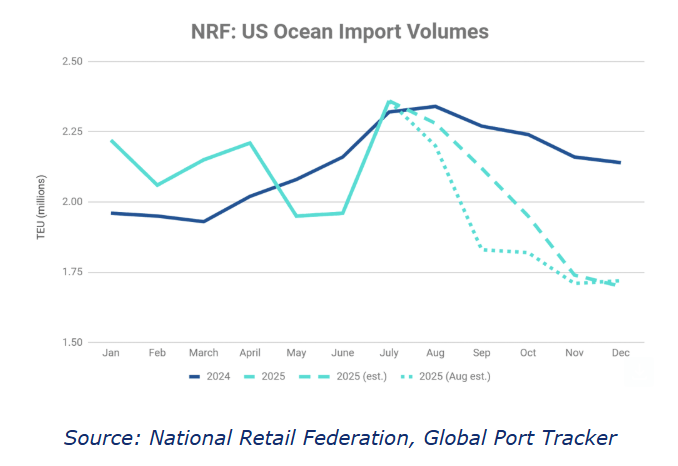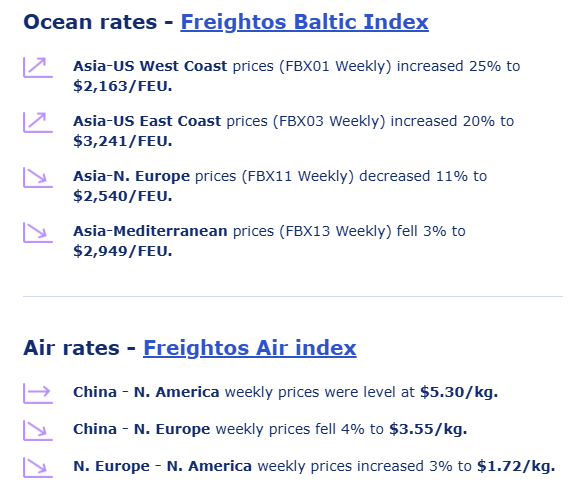 Freightos Weekly Update
Freightos Weekly Update
- Source
- Freightos
- Source Link
- https://www.freightos.com/
- Frequency
-
Weekly
Tuesday
- Next Release(s)
- December 2nd, 2025 12:00 PM
-
December 9th, 2025 12:00 PM
-
December 16th, 2025 12:00 PM
-
December 23rd, 2025 12:00 PM
-
December 30th, 2025 12:00 PM
-
January 6th, 2026 12:00 PM
-
January 13th, 2026 12:00 PM
-
January 20th, 2026 12:00 PM
-
January 27th, 2026 12:00 PM
-
February 3rd, 2026 12:00 PM
-
February 10th, 2026 12:00 PM
-
February 17th, 2026 12:00 PM
Latest Updates
-
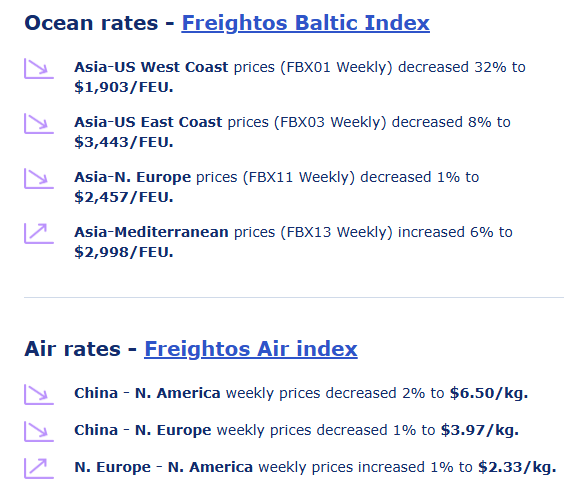
Analysis
Despite higher tariffs since early this year, US retail sales have proved resilient and are expected to grow through the holiday season. The solidifying tariff landscape is nonetheless facing destabilizing forces like recent China-Japan tensions, and the US Supreme Court’s pending decision on the legality of Trump’s IEEPA-based tariffs.
But the White House is signalling it is already taking steps to ensure that a SCOTUS loss will not open a low tariff window. So, if consumer spending remains strong, and the status quo of the trade war holds up, the US could enter a restocking cycle in 2026 as frontloaded inventories wind down. This restocking could mean stronger freight demand than some have anticipated for next year.
On the freight supply side though, there is more and more discussion of container traffic’s coming return to the Red Sea as the fragile Israel-Hamas ceasefire remains in effect. And while most carriers are not offering a timeline, ZIM’s CEO recently stated that a return in the near future is increasingly likely.
The shift of most of the 30% of global container volumes that normally transit the Suez Canal away from the Red Sea and around the Cape of Good Hope almost exactly two years ago added seven to ten days and thousands of miles to Asia - Europe journeys and to some Asia - N. America sailings as well.
The return of container traffic to the shorter Suez route will result in the sudden early arrival of these ships, which will mean significant vessel bunching and congestion at already persistently congested European hubs. This congestion will cause delays and absorb capacity which could push container rates up on the affected lanes, and possibly beyond.
Carriers have plans for a gradual phase in of the transition back to the Red Sea, with smaller vessels starting to transit first. This approach would still cause vessel bunching, but would be aimed at minimizing the impact of the reset as much as possible.
But some carriers are skeptical that an orderly phase-in will happen, as they expect pressure from customers who will want a return to the shorter route as quickly as possible. Analysis from Sea Intelligence suggests that the more gradual the transition, the less disruptive it will be, while the faster it is the more disruptive it will be, and the more pressure it will put on freight rates during the up to two months it will take for schedules to return to normal.
Ocean expert Lars Jensen also notes that a return during the lead up to Lunar New Year would coincide with an increase in demand, and would put more pressure on ports and rates than if the transition takes place post-LNY when demand is typically weak.
The capacity absorbed through Red Sea diversions pushed East-West rates up to highs of $8,000 - $10,000/FEU in 2024 and set a highly elevated floor of $3,000 - $5,000/FEU during low demand periods that year. But even with Red Sea diversions still in place this year, rates on these lanes have consistently been significantly lower than last year, with prices on some lanes reaching 2023 levels for a span in early October.
The transition back to the Suez Canal – be it more or less chaotic – will ultimately release more than two million TEU of container capacity back into the market. This surge will put even more downward pressure on rates and increase the challenge of effectively managing capacity for carriers seeking to keep vessels full and rates profitable.
The current overcapacity on the East-West lanes is the main reason that carriers’ November transpacific GRIs which had pushed West Coast rates up by $1,000/FEU this month to about $3,000/FEU have now fizzled.
Asia - N. America West Coast prices fell 32% last week to $1,900/FEU with daily rates this week down another $100 so far, but prices remain above the $1,400/FEU low for the year hit in early October. Last week’s vessel fire at the Port of LA does not seem to have had an impact on prices as operations have quickly recovered. Rates to the East Coast fell 8% to $3,400/FEU last week but are at $3,000/FEU so far this week, about even with levels in early October before these set of GRI introductions.
Meanwhile, October and November’s GRIs on Asia-Europe lanes have stuck, with rates to Europe and the Mediterranean both 40% higher than in early October at $2,500/FEU and $3,000/FEU respectively. These rate gains may be surviving on aggressive blanked sailings on these lanes.
Carriers are planning additional GRIs for December aiming for the $3k-$4k/FEU level as they continue to reduce capacity – with an announced labor strike in Belgium likely to help absorb some supply – but there are signs that these increases may not take.
In air cargo, peak season demand is driving rates up and should keep doing so for the next couple weeks. Freightos Air Index data show ex-China rates remaining strong at about $6.50/kg to N. America and $4.00/kg to Europe last week. Demand out of S. East Asia has grown significantly during this year’s trade war, with rates also elevated on these lanes at $5.40/kg to the US and $3.50/kg to Europe.

